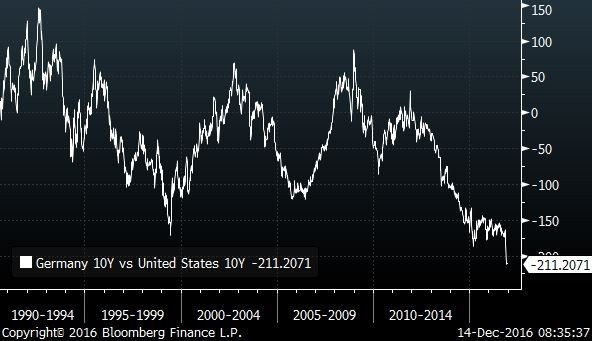By guest contributor Michael Boye from Saxo Bank
The 2016 edition of the intercontinental and almost century-old Ryder Cup rivalry in men’s golf between the US and Europe ended in favour of the US. While European golfers will have to wait until 2018 for their revenge on the greens, in global bond markets next year Europe could very well be the unexpected winner and reason that the yield gap between these two arch rivals — creatively known as the Ryder Cup spread — is likely to narrow in our view.
It has now been more than five years since the 10-year government yields of Germany and the United States matched up, as the monetary policies of the two major central banks have gone in opposite directions since then. The Federal Reserve has abandoned its quantitative easing programme, hiked interest rates once, and another rate hike seems a foregone conclusion at this week’s policy meeting, with financial markets even assigning an 8% chance of two rate hikes.
Europe, on the other hand, seems to struggle with chronically low economic growth, despite the European Central Bank even surpassing its Bernanke-led counterpart in venturing into the corporate bond market. Last week though, on the back of growing confidence in the European economic outlook, ECB president Mario Draghi surprised the markets by announcing a tapering of bond purchases to 60 billion euros a month.
The consequence of this policy divergence has been a widening of the Ryder Cup spread to currently more than 210 basis points, which is the widest gap since the inception of the euro. As the long-dated chart below shows, higher interest rates in the US aren’t exactly a natural low — in fact, the opposite seems just as common. Furthermore, a reasonable case could be made to suggest some historical mean reversion between the pair as well.
Ryder Cup spread: the difference between US and German 10-year sovereign yields

Source: Bloomberg

